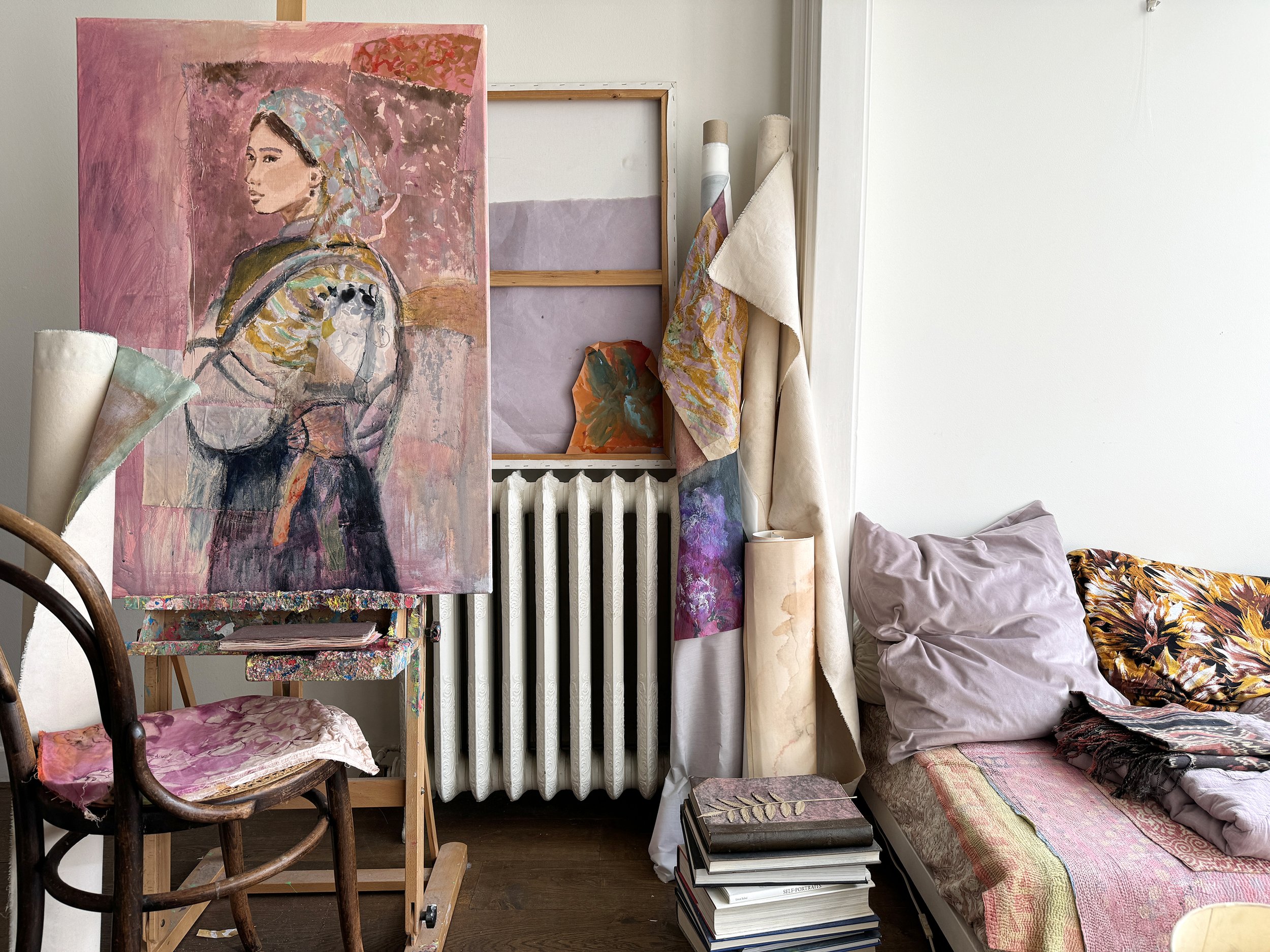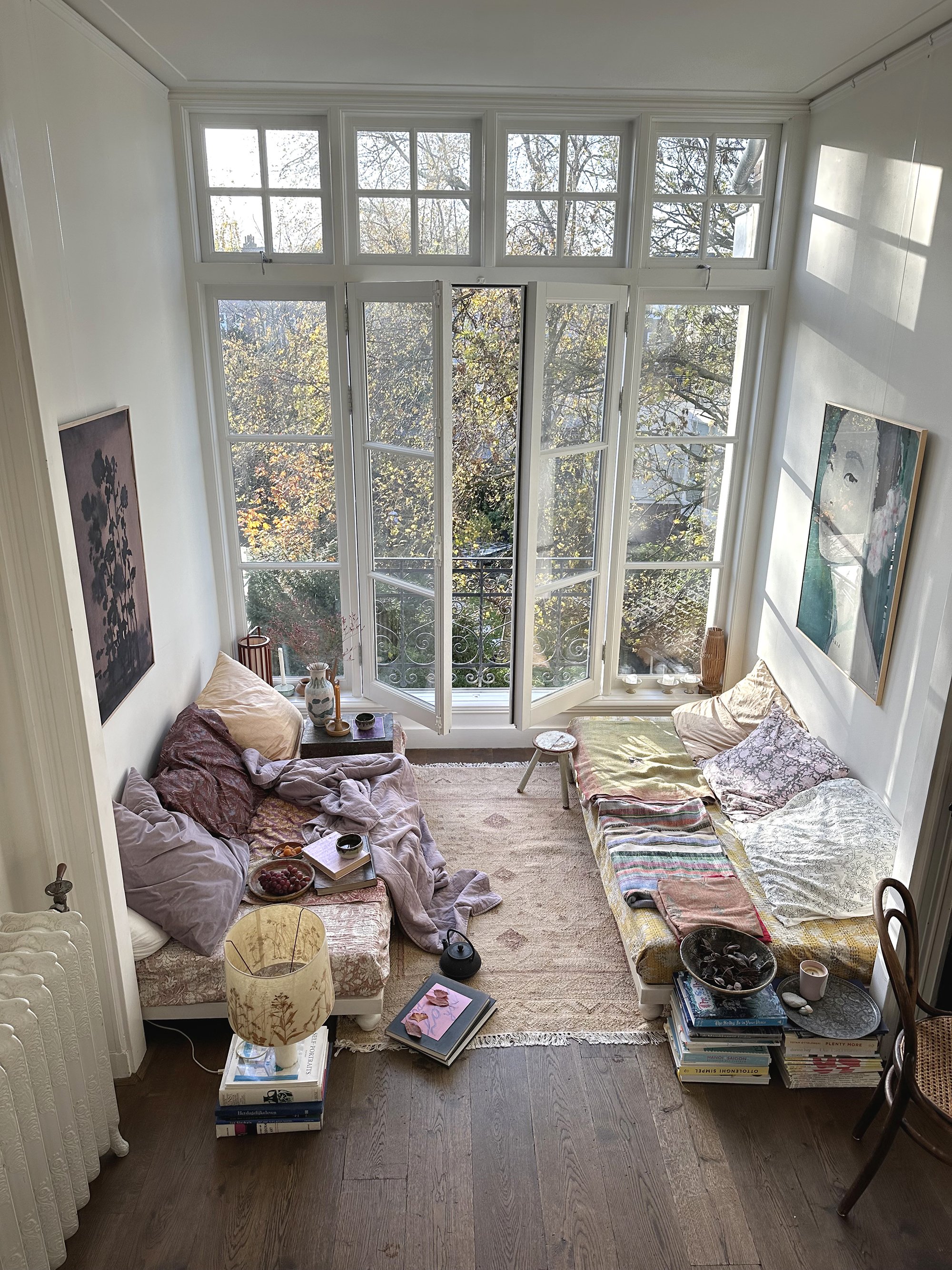Tiny de Vries
Tinystories
A Journey of Art and Inspiration
Tiny de Vries, a Dutch artist with a global perspective, weaves together the threads of nature, memory, and imagination in her captivating artwork. Raised in a creative household, she developed a deep appreciation for art and design from a young age. Her work is a reflection of her travels, her experiences, and her unique perspective on the world. Join us as we delve into the world of Tiny de Vries, exploring her artistic journey and inspirations.
Hello Tiny, how are you today?
Thank you so much, I’m very good. Currently I’m traveling in the Atlas mountains in Morocco and hosting a creative retreat.
Could you introduce yourself?
I’m an artist, born in Elburg, a charming tiny medieval town in the Netherlands, and raised in the countryside, where we had a lovely, untamed garden.
Creativity ran deep in my family, my father, an architect, and my mother, an artist, instilled in us a love for making things with our hands. We spent hours working in the garden, growing our own vegetables, and designing and sewing our own clothes. Our days were filled with music, from ballet to piano lessons, and every spare moment was spent drawing and painting, surrounded by the wild beauty of nature.
How did your exposure to art at a young age shape your artistic journey?
Art in its many forms, music, dance, sculpture, architecture, and painting has always been intertwined with my life. Growing up, I was immersed in a creative environment where artistic expression was not just encouraged but a part of daily living.
Where do you find inspiration for your art? How do your surroundings, emotions, and experiences influence your creative process?
I find a lot of inspiration in nature, landscapes, flowers, and the ever changing beauty of the natural world. Nature is a constant source of ideas and energy for me, whether it’s the colors, the texture of leaves, or the delicate details of a flower.
My travels also play a big role in shaping my creativity. Emotions and personal experiences also weave their way into my work, allowing me to blend what I see outside with what I feel within, creating a unique connection between my surroundings and my inner world.
Additionally, my rich imagination plays a significant role in inspiring my artwork. I can view the world like experiencing everything as if seeing it for the first time. This sense of wonder allows me to appreciate the beauty in the simplest things and infuses my art with a sense of playfulness and curiosity. I try to capture the magic, and intricacies of the world around us, inviting others to rediscover the joy and beauty that often goes unnoticed.
Can you tell us about the metaphors and symbols you often use in your illustrations?
Light, in its symbolic sense, is a recurring theme in my illustrations. It represents hope, clarity, and the passing of time.
Nature, particularly flowers, also plays a significant role in my work, serving as symbols of beauty, growth, and the cycles of life. I often explore the idea of impermanence, embracing the fleeting nature of life just as it exists in the natural world. Through these metaphors, I aim to capture the delicate balance between light and shadow, growth and decay, reminding us of the beauty found in both.
Losing my dear sister when I was 16 and she was just 13 had a profound impact on my life. This loss instilled in me a deep desire to seek out light, both literally and metaphorically. The theme of searching for light has become a central subject in my work, reflecting my journey through grief and the pursuit of hope. It reminds me to find beauty even in the darkest moments and to celebrate the memories of those we’ve lost. This personal experience informs my art, guiding me to create pieces that evoke feelings of resilience, connection, and the enduring presence of love.
Your work explores the relationship between nature and the human psyche. Can you elaborate on this connection and how it manifests in your art?
When I’m outside, I find clarity; walking barefoot allows me to truly connect with my surroundings, feeling, hearing, and seeing. This connection profoundly influences my art.
The Western notion that humans own nature, and that it exists to serve us, contrasts with perspectives in other cultures, which I find very fascinating.
Many Indigenous cultures in Asia and South America, for example, describe nature as a world filled with human and non-human beings, all of whom are considered persons.
I love to see the world this way, more connected with our surroundings.
How do you believe art can impact people’s lives?
Art has the power to shift perspectives, allowing people to see the world in a different way. It can give fresh insights, and new ways of looking at things. Through art, we can challenge our perceptions, broaden our understanding, and connect with emotions and experiences we might not have otherwise explored. Art can inspire change, provoke thought, and create deeper connections between people and the world around them.
Which materials do you prefer to use. How do you choose the best medium to express your ideas?
I enjoy mixing various materials in my work, as I don’t prefer to be confined to a single medium. Each piece calls for its own unique expression, so I choose based on the color, whether it’s transparent or opaque, the texture I want to achieve, or the fluidity I desire. This approach allows me to explore and experiment freely, enabling my ideas to evolve organically and reflect what Im creating.
Your use of color and texture is beautiful. Can you talk about your approach to these elements and how they contribute to your aesthetic?
Thank you so much! I have a habit of collecting small color samples during my walks in my hometown or while traveling. These can be anything from snippets of paper to dried leaves, flowers, or other materials. I store these treasures in my studio in little boxes, where they serve as a source of inspiration.
My approach to color is very personal and intuitive and also these collections inspire my color palette and help me create a tactile, layered aesthetic in my work.
How has your artistic style evolved over time? Are there any new directions or areas of exploration you’re interested in pursuing?
My artistic style hasn’t changed much, but my experiences in different countries greatly inspire me. The colors, landscapes, and people I encounter influence my work, adding new layers and nuances to my expression. Each place offers a unique perspective that enriches my art.
What were the most significant cultural and personal experiences you had during your travels around the world? How did these experiences influence your artistic style and themes?
Each country I visited offered unique perspectives, from the vibrant colors and intricate patterns of Indonesia’s batik and ikat textiles to the colors of Marrakech and the Sahara and the rich traditions of Moroccan art and architecture.
And I love to learn about local craftsmanship, thats so inspiring.
Can you tell us about your experiences in Morocco and Indonesia and how these cultures have influenced your work?
After graduating from the University of the Arts in the Netherlands, I moved to Indonesia, where I continued to work and study art. The rich history of artistic traditions in Indonesia, like textile art forms like batik and ikat, has inspired me.
What are some of the most important life lessons you’ve learned through your artistic journey?
One of the most important life lessons I’ve learned through my artistic journey is to trust my intuition. I’ve discovered that following this intuition leads to some of my most interesting work. Staying true to myself and honoring my emotions is crucial, as it allows my art to reflect my authentic experiences and perspectives.
What are your goals for the future? Are there any specific projects or exhibitions you’re working on?
I don’t have really plans, when it crosses my road I’ll love it. I always prefer to live my life without rigid goals or detailed plans. I cherish and trust the journey itself. This approach allows me to remain open to new experiences and opportunities as they arise, I love the unexpected and meaningful directions.
What advice would you give to young artists who are just starting out?
My experience studying at the University of the Arts was transformative, providing different levels of discovery and rich discussions that helped me learn about myself as an artist. My advice to young artists is to stay close to your authentic self and be true to your unique voice.
Tiny de Vries - @tinystories.nl
www.tinystories.nl
shop the Tinystories’ book - An Artist’s Journey























